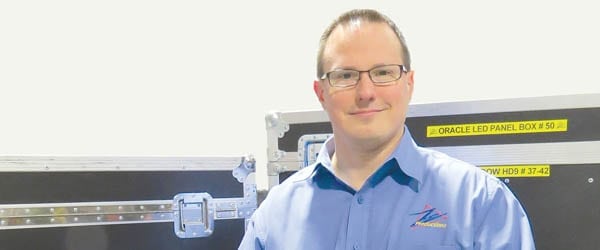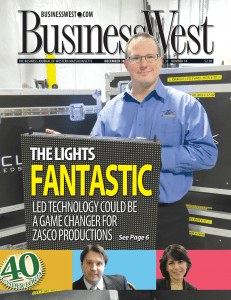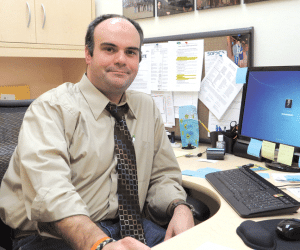
The Lights Fantastic
LED Technology Could Be a Game Changer for Zasco Productions
 Mike Zaskey says LED (light-emitting diode) technology has been on his radar screen for more than a decade now.
Mike Zaskey says LED (light-emitting diode) technology has been on his radar screen for more than a decade now.
He understood its vast potential to open new doors for the company he founded, Chicopee-based Zasco Productions, by enabling it to contend for projects — and there are many of them — that could benefit from the technology’s ability to produce a sharp, bright, high-quality video display image, even in direct sunlight, a considerable improvement over projection technology.
But he also understood its high price tag and how difficult — especially years ago, when this technology was considerably more expensive — it would likely be to recover it. “Virtually unattainable” was the phrase he used to describe the product for most of that decade.
Indeed, he and Barry Gadbois, manager of Operations and Business Development and also video director for the company, would spend countless hours at a whiteboard in Gadbois’ office crunching numbers and trying to get them to work.
Finally, last spring, they were confident that they could.
So Zasco proceeded with the purchase of Oracle LED Systems’ Black Widow HD9 indoor/outdoor display modules — 80 2-by-2-foot tiles, to be exact, which can be joined to create two 10-by-16-foot screens or a host of other configurations. The company’s marketing piece to prospective customers calls it “New England’s premier visual display system,” and then goes into much more detail, with bullet points such as these:
• “True 9mm resolution, 3-in-1 SMD LEDs for superb clarity”;
• “7,000 nits of brightness so that every image leaps off the screen, even in direct sunlight”;
• “Weather-resistant to shine through the toughest conditions!”;
• “Ability to create curved surfaces, plus an innovative frameless flex kit, and other features, make virtually any scenic application possible”; and
• “A network of nationwide cross-rental partners means that we can build nearly any size or number of displays!”

Barry Gadbois says the LED display used at the Rays of Hope event last fall is a good example of how the technology allows groups to make “eye contact” with large audiences.
“This technology puts us on a different playing field,” he said, noting that the technology was used for concerts at this year’s Big E, the 20th annual Rays of Hope walk in October, and other events. “It’s a door opener for us.”
Gadbois agreed.
“There’s a certain level of client that requires service on a large scale that was inaccessible to us because we couldn’t meet the largest part of their needs, which was display technology like this,” he explained. “Now, we can go to clients who were inaccessible before and tell them, ‘not only can we cover your display needs, we can do it with the best stuff on the market, and we’re also a turn-key provider for all the other services you need.
“It’s a game changer for us,” he went on, “because it gives us a chance to introduce ourselves, and our core services, to customers who may have passed us over before because we didn’t have these displays.”
Zasco said the Black Widow system also gives Zasco an opportunity to fill out its calendar and provide a more level revenue stream, an important consideration for any business. He noted that the company is most busy in the late spring and early summer, with college commencements, corporate meetings, and other events, “but in July, we’re often sitting here waiting for the phone to ring. This will hopefully make it ring more often.”
For this issue, BusinessWest takes an indepth look at the Zasco company, its latest investment in technology, and how it has taken Zaskey and Gadbois from their work at that whiteboard to a new assignment — aggressively rewriting the business plan to reflect new opportunities.
Nit Withstanding
As he talked about the Black Widow, and LED technology in general, Zaskey drew a number of comparisons to HD televisions.
They’ve been around for years, he noted, and the technology has greatly improved while the price has come down considerably. In other words, the first person on the block to get one paid considerably more than someone who waited a few years. Meanwhile, that first one in has a set that today isn’t exactly obsolete, but it’s not as good as the newer editions.
“Like everything else that’s technology-driven, the quality increases and the price comes way down,” he explained, referring to LED systems. “And that gives us a competitive advantage, especially over some companies in the eastern part of the state that invested in this technology in the late ’90s and are possibly still trying to recoup those very large investments. It’s older technology, and they have to charge a premium for it.”
This phenomenon essentially explains what all the work with that whiteboard was all about, said Zaskey, adding that, while an investment in this kind of technology is always somewhat of a gamble, especially for a company of this small size, he and Gadbois were researching and waiting for something that they could consider a relatively safe bet.
And they believe they’ve made one, with the purchase of a system that is versatile, affordable (or at least much more so than what was on the market years ago), and won’t be obsolete before the end of next year, or this decade.
“We bought a product that’s very mature — this is as high a resolution value as we’ve seen in an outdoor display, and it’s probably as high a resolution value as anyone is going to bother to make,” said Gadbois. “The expense of developing something better than we have is probably prohibitive.”
The LED technology ushers in a new chapter in the life of an intriguing local company, one that got its start when Zaskey was in middle school learning how to handle a video camera.
What started as a hobby — videotaping weddings for family and friends of the family — eventually became a business, thanks to startup financing from his father. By the time he graduated from high school, Zaskey was starting to diversify into corporate work, such as training videos.
Eventually, companies that hired him started asking about how to display those videos at events. He saw an opportunity and invested in projection, lighting, and audio equipment, and essentially changed the course of what by then had become Zasco Productions.
Over the past 20 years, growth has been consistent, averaging about 10% annually, he said, and while most of the company’s work is in this region, it has been involved in projects in Las Vegas and other major cities, mostly east of the Mississippi.
Fast-forwarding to when LED technology came onto his radar screen, Zaskey said that, business-wise, the need for such an investment was growing because large-screen displays were now commonplace at corporate events and gatherings such as commencements, and projection technology has its limitations.
“The challenge has always been displaying video outside, in direct sunlight, or where ambient lighting conditions cannot be controlled. LED technology makes that possible. Projection outside is simply not an option — there’s just no projection that can compete with sunlight.”

Barry Gadbois says consumers are becoming more demanding when it comes to video presentations, and LED technology is now an expectation.
“People have become accustomed to a very high level of technology, especially when it comes to video and audio,” Gadbois explained. “No one would now consider it acceptable to go to a major-league baseball game and see a scoreboard with little white lights. We’ve come to expect a very immersive, very technically advanced experience, and the natural extension of this is that it’s trickling down; it’s not just major-league ballparks or the biggest concerts or the biggest events. People have high expectations for their experience.”
As an example, he pointed to the Big E, which had essentially gotten by with projection technology at its concerts for years, but had, with its vendor, KMJ Video (a Zasco client), reached the conclusion that the target audience wanted, and deserved, something better.
“They [KMJ] were ready to make a move and enhance the experience for their customer,” said Zaskey, “and the timing was perfect, because we had just acquired this new technology.”
That aforementioned trickle-down effect has now reached college commencements — “parents want to see their son or daughter on a big screen in a sharp, high-definition image,” said Gadbois — as well as corporate gatherings and many other kinds of events, and this phenomenon was one of the factors that led the company to invest in LED technology, and to believe it will prove to be a very fruitful investment.
Shedding Light on the Subject
Now that Zasco has made this leap forward, said Zaskey and Gadbois, the obvious challenge becames making the most of the opportunity it presents.
“Equipment like this has to be in use,” said Zaskey, underscoring the assignment that faces any business that makes a large capital investment aimed at driving new business.
Elaborating, he said the work now facing the company involves everything from aggressive marketing to educating potential customers about how LED technology can add value, as well as quality, to their events, to expanding their horizons geographically.
And when it comes to the marketing and educational components of this assignment, there are inherent challenges, said Gadbois, adding that people need to see and experience the technology to understand what it can do.
“This isn’t a product you can put in your briefcase, bring to a client, and show it to them on their conference table,” he explained. “You can’t always build a 16-foot-wide wall for people. But if they can see it … there hasn’t been anyone, including us, who hasn’t looked at this for the first time and said, ‘wow, this really looks incredible.’
“Once we realized that we had a product that showed itself so well,” he went on, “we quickly understood that we had to get this in front of people.”
Zasco had a huge display of the LED technology at the Western Mass. Business Expo in November, and has marketed the technology in many other ways as well, said Zaskey, adding that perhaps the most effective promotional vehicles have been the recent events that have put the Black Widow system to the test.
Most of the 20,000-plus participants in this year’s Rays of Hope event were able to see for themselves, said Gadbois, adding that the LED technology (one 10-by-16 screen positioned near the starting line) gave organizers an opportunity to connect with the walkers and runners more effectively than in years past, when they had only a microphone with which to communicate.
“We changed their audience experience,” he explained. “Previously, they had a stage and sound. They have a crowd of thousands of people stretched over a large area. This technology enabled people to see and also hear, which is important.
“If you’re attending this event and not visually engaged — maybe you hear parts of what’s going on, but you’re talking to people around you because you’re distracted — that’s a completely different audience experience than if you can literally make eye contact and create a little bit of a relationship with a speaking subject typically talking about something that’s powerful and designed to motivate the audience,” Gadbois went on. “When you can make eye contact with 20,000 people, that’s a pretty neat experience, and we try to help our clients understand and leverage the value of that kind of power.”
And value can come in ways beyond this eye contact, said Zaskey, adding that nonprofits can use an LED display to provide creative and highly visible exposure to sponsors, a reality that could enable the technology to essentially pay for itself in such instances.
Looking ahead, he said the company’s investment should provide opportunities on a number of levels. As he said earlier, it will open doors that had previously been closed, and, once those doors are open, enable Zasco to present its full roster of services to those clients.
It could also make the company a bigger player in the Boston area and other large municipal markets where competitors may have older LED technology and, very possibly, a higher price tag for their services.
Meanwhile, because of the growing demand for high-quality video displays, Zasco could become a vendor, or partner, with competitors who don’t have LED technology but need it to satisfy increasingly demanding clients. Zaskey called such opportunities “good consolation prizes,” meaning Zasco didn’t get the contract but did get a chance to rent out its equipment, and said these could become a new and possibly lucrative revenue source.
“If you’re not going to win the whole pie, it’s always nice to have a piece of the pie,” he explained. “And this technology will give us many more opportunities to do that.”
A Bright Future
Zaskey told BusinessWest that the term LED has gone well beyond buzzword status in recent years. It has become, in many respects, a standard and an expectation for an increasingly demanding public.
“Anything LED sparks an emotion in people,” he said. “You have LED uplighting, LED lighting in your home that’s more energy-efficient. So when people say they have LED visual displays at their event, that elicits a response from their audience and gets people excited.”
The hope at Zasco is that this emotion grows stronger in the years to come. If it does, then this investment will certainly bring a return for a company that is now, more than ever, focused on the big picture.
George O’Brien can be reached at [email protected]






